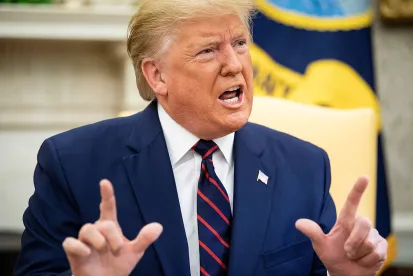Part I: President Trump’s Executive Actions
On the evening of Friday, August 7, after over two weeks of almost daily negotiations between Democratic leaders and Treasury Secretary Mnuchin and White House Chief of Staff Mark Meadows over what most are referring to as “Phase 5” of the coronavirus stimulus – “Phase 4” being the Coronavirus Aid, Relief, and Economic Security Act, as amended (CARES Act) – discussions between the parties broke down without a deal. As a result, the following day, President Donald Trump signed an executive order and three presidential memorandums (Executive Actions) aiming, as he said during an August 8 press briefing, to provide “immediate and vital relief to Americans struggling in this difficult time.”
Given that negotiations are likely on hold until September due to the congressional recess, we are taking this opportunity to provide updates on the impact of the Executive Actions and on where things stand with respect to the Phase 5 negotiations. Because there are a number of proposals on the table, we have broken our summary into the following four parts (each to be a separate Client Alert):
Part I: President Trump’s Executive Actions (this Alert)
Part II: PPP Revisions and Second PPP Loans
Part III: The RESTART Act and the Long-Term Recovery Sector Loan Program
Part IV: Tax Credits and Other Stimulus Programs for Businesses
We hope these summaries serve as a resource and guide for readers during these unprecedented times. We expect Parts II through IV to be released over the course of the next few weeks.
Part I: The Four Executive Actions Issued by the White House
The four Executive Actions are the White House’s attempt to bypass the current gridlock surrounding the Phase 5 negotiations and they address the following issues: (1) deferring a portion of payroll taxes paid by employees, (2) providing supplemental payments for lost wages, (3) extending the federal moratorium on evictions, and (4) extending the deferment of federal student loan payments.
As a threshold matter, even though three of the four Executive Actions are styled as presidential memorandums, as opposed to executive orders, they are all considered to be presidential actions with the same force of law on the executive branch. The primary differences between the two are that executive orders (1) are considered to take precedence over a memorandum (to the extent there is a conflict), (2) are required to be published in the Federal Register, (3) require the White House Office of Management and Budget to include a cost estimate, and (4) require a citation of the authority the President has to issue it. Executive orders and presidential memorandums both generally require additional actions by federal agencies and other third parties in order to implement them and their constitutionality can be challenged in court.
While none of the Executive Actions have been implemented yet and some may ultimately be challenged, we hope this summary, in conjunction with the forthcoming Alerts mentioned above, provide some insight on where negotiations currently stand and what terms may be included in any Phase 5 stimulus package. In addition, because the Executive Actions are intended to extend certain provisions of the CARES Act, there is a chance some or all of them will be implemented if the Phase 5 negotiations continue to drag on.
Memorandum on Deferring Payroll Tax Obligations in Light of the Ongoing COVID-19 Disaster (found here)
This memorandum has probably received the most attention since it is the Executive Action that most directly impacts businesses and employees. Subject to the limitations described below, it authorizes the Treasury Secretary to defer, for up to a year, the 6.2% payroll tax imposed on employee wages under IRC §3101(a) (i.e., the employee’s portion of Social Security taxes). The memorandum does not address the employer’s matching portion of Social Security, since employers are currently eligible to defer those under the CARES Act until the end of 2021 when 50% of those payments are due and 2022 when the remaining 50% is due.
Specifically, this memorandum would allow for the deferral of the employee portion of any Social Security taxes paid between September 1, 2020 and December 31, 2020, subject to the following conditions:
-
the deferral only applies to employees “generally” earning less than $4,000 during an applicable bi-weekly pay period (i.e., $104,000 annually). It is not clear how bonuses or other extraordinary payments impact the calculation of an employee’s compensation for the purpose of qualifying for the deferral. Details are expected in further guidance issued by the Treasury; and
-
the amounts deferred are not subject to “any penalties, interest, additional amount, or addition to the tax.”
In addition, the memorandum orders the Secretary of the Treasury to “explore avenues, including legislation, to eliminate the obligation to pay the taxes deferred [emphasis added] pursuant to the implementation of this memorandum.” Three practical issues this language is likely meant to address are (1) pursuant to IRC §7508A, the Treasury Secretary is authorized to postpone certain tax deadlines by up to one year in the event of a federally-declared disaster, but the Secretary is not authorized to forgive such taxes without legislation, (2) since the employee’s portion of Social Security taxes are being deferred, employees will still have to pay those taxes (and employers subsequently deposit them with the IRS) upon the expiration of the deferment period, and (3) if an employee’s employment is terminated for any reason, it is unclear how any deferred payroll taxes would be recouped by the employer. The repayment of these taxes creates significant logistical constraints for employees, employers and the IRS and, balancing these concerns, there may be little incentive for deferring 6.2% of compensation only to have to repay it in full in the relatively near future. In a recent interview, Secretary Mnuchin indicated the deferral would be voluntary for employers, which provides some insight on how several of the above issues may be addressed in the final guidance.
Given the issues mentioned above, the rollout and impact of this program requires additional guidance from the Treasury, which we expect to be released prior to September 1.
Memorandum on Authorizing the Other Needs Assistance Program for Major Disaster Declarations Related to Coronavirus Disease 2019 (found here)
This memorandum authorizes the Federal Emergency Management Agency (FEMA) to use up to $44 billion of its $70 billion disaster relief funds (DRF) to provide “supplemental payments for lost wages” to certain individuals. The funding of the DRF is separate from the COVID-19 pandemic and those funds are typically set aside to assist in the event of natural disasters. The memorandum also allows states to access the remaining $80 billion in available funds under the Coronavirus Relief Fund, which was created under the CARES Act, to, as discussed below, pay their portion of the costs associated with the program. The reason for this cost sharing arrangement is 42 U.S. Code § 5193, which details how DRF funds can be used, requiring the federal share of assistance to not exceed 75% of the eligible costs of the disaster. It is unclear if states accessing the Coronavirus Relief Fund, which technically appears to be federal funding, to pay their 25% portion would circumvent this statutory requirement.
This program is intended to replace the now-expired $600 per week Federal Pandemic Unemployment Compensation program included in the CARES Act, but with the following material adjustments: (1) it only applies to recipients receiving at least $100 per week of lost wage assistance from an existing federal or state unemployment program (other than the $600 per week Federal Pandemic Unemployment Compensation program), (2) it reduces the total weekly payments received by individuals from $600 to $400, (3) it allows states to access any funds available in the Coronavirus Relief Fund to pay their 25% portion of the $400 supplement (i.e., $100), and (4) there is no requirement that states participate in the program.
In addition, instead of the comparably frictionless implementation of enhanced benefits under the CARES Act, this memorandum requires each state’s governor to “request lost wages assistance” and “administer delivery and provide adequate oversight of the program.” These and the other logistical and financial challenges mentioned above, when combined with the likelihood of legal challenges from states and other third-parties, makes it unlikely that the program will be implemented as currently constructed.
Finally, as mentioned above, this memorandum restricts recipients to individuals receiving at least $100 per week of lost wage assistance from an existing federal or state unemployment program (other than the $600 per week Federal Pandemic Unemployment Compensation program) and who certify they are “unemployed or partially unemployed due to disruptions caused by COVID-19.” This limitation seems aimed at prohibiting part-time employees, gig workers and sole proprietors from participating in the program. This limitation alone could exclude up to 1.5 million people from receiving these enhanced benefits.
Executive Order on Fighting the Spread of COVID-19 by Providing Assistance to Renters and Homeowners (found here)
Unlike the three memorandums, this action was issued as an executive order and is aimed at minimizing “residential evictions and foreclosures during the ongoing COVID-19 national emergency.” The issuance of this order coincides with the July 31 expiration of the federal moratorium on evictions (for properties with federally-backed mortgages) contained in the CARES Act.
Specifically, the order directs various federal executive departments to:
-
consider whether any measures temporarily halting residential evictions of any tenants for failure to pay rent are reasonably necessary to prevent the further spread of COVID-19 from one State or possession into any other State or possession;
-
identify any and all available Federal funds to provide temporary financial assistance to renters and homeowners who, as a result of the financial hardships caused by COVID-19, are struggling to meet their monthly rental or mortgage obligations;
-
promote the ability of renters and homeowners to avoid eviction or foreclosure resulting from financial hardships caused by COVID-19 (including by encouraging and providing assistance to public housing authorities, affordable housing owners, landlords, and recipients of Federal grant funds in minimizing evictions and foreclosures); and
-
review all existing authorities and resources that may be used to prevent evictions and foreclosures for renters and homeowners resulting from hardships caused by COVID-19.
Unlike the clear moratorium on evictions contained in the CARES Act, these four directives are effectively requesting various federal agencies to consider what assistance they can provide, including a moratorium on evictions and a way for landlords and other housing providers to seek rent replacement or other reimbursement in exchange for not evicting tenants. Without an actual moratorium and no reimbursement or other credits to landlords for missed rent payments, it is unclear if this order will ultimately have any impact and, without further guidance or legislation, the order contains no relief for tenants or restrictions on what actions landlords may take.
Finally, even though this executive order will likely have limited impact at the federal level, as of August 1, approximately 20 states, the District of Columbia and a number of cities, counties and other municipalities had eviction moratoriums in place. In addition, in jurisdictions where there is not a moratorium, many local courts are significantly behind in processing eviction complaints due to court closures and other logistical challenges resulting from COVID-19. However, it is expected that eviction filings will increase significantly in states where no moratorium is in place, which is likely the primary reason why the White House decided to issue this executive order.
Memorandum on Continued Student Loan Payment Relief During the COVID-19 Pandemic (found here)
The final Executive Action seeks to address the expiration on September 30 of the federal student loan payment relief provided under the CARES Act by directing the Secretary of Education to take appropriate action to (1) modify “the requirements and conditions of economic hardship deferments” under current legislation, and (2) “provide such deferments to borrowers as necessary to continue the temporary cessation of payments and the waiver of all interest on student loans held by the Department of Education until December 31, 2020.”
Borrowers are not required to participate in the deferment program, and they can continue to make loan payments in the ordinary course if they choose to do so. The deferments only apply to federal loans (and not private loans), which is the same as what is currently in place (until September 30, 2020) under the CARES Act.
Similar to the other Executive Actions, this memorandum is not law and student loan borrowers interested in participating in the deferment program should look for further guidance from the Department of Education.
Next Client Alert
In Part II of our Client Alerts, which will be coming in the coming days, we will review the proposed revisions to the Paycheck Protection Program and the Second Paycheck Protection Program. Feel free to reach out to your Womble Bond Dickinson contact or to one of us to discuss these matters and how they may apply to your specific circumstances.






 />i
/>i

